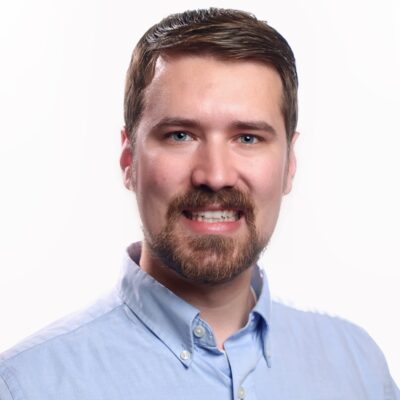Student Spotlight: Joshua Luoma

July 14, 2025
Joshua Luoma is a doctoral candidate in applied physics from La Crescent, Minnesota. He earned his B.S. in engineering physics from the University of Wisconsin-Platteville and now studies plasmas generated by high intensity lasers under the guidance of Gennady Shvets at Cornell.
What is your area of research and why is it important?
I study plasmas generated by high intensity lasers, which are short pulses of light – existing for only a trillionth of a second – with a power exceeding the solar radiation that hits the state of New York. These pulses create an extremely hot, ionized plasma that can be utilized to generate beams of electrons, ions, X-rays, and even antimatter. I use computational and experimental techniques to investigate different types of target geometries that can fine-tune our control over the plasmas we create, enabling a more efficient conversion to the various products formed by laser-plasma interactions.
What are the larger implications of this research?
Among the most impactful and exciting applications of laser plasmas is the ability to create net energy from controlled fusion reactions. I am studying targets that generate a high flux of ions and can improve the energy yield from fusion capsules. Harnessing fusion energy would give us access to an abundant, clean, and reliable power supply. Fusion would revolutionize the energy market, and it is my dream that one day we can make use of low-cost fusion fuel to help restore and protect our environment for generations to come. Large challenges remain before fusion will be practical, but steady progress in the design of plasma targets and lasers provides hope for the realization of a fusion future.
What does it mean to you to have received a Department of Energy Laboratory Residency Graduate Fellowship?
I was honored to receive the Laboratory Residency Graduate Fellowship, which funds my research at Cornell and supports a rich collaboration with Lawrence Livermore National Laboratory (LLNL). The fellowship program is designed to facilitate relationships between academic institutions and national laboratories while training the future workforce in research areas vital to national interests. Participating in this mission has been a meaningful experience with the added benefit of expanding my professional network to include many national lab scientists.
What will this fellowship allow you to do that you might not have otherwise?
The fellowship has a unique residency program that allows fellows to work on-site at national laboratories. The national lab environment offers unparalleled experimental and computational resources alongside a large community of experts in fields like plasma physics, optics, and material science. I am working closely with LLNL, and this opportunity has enhanced my research and expanded my knowledge about laser plasma physics. While the bulk of my work revolves around numerical simulations, I was encouraged to join an LLNL experiment during my first residency. Since then, I have participated in multiple experimental campaigns and will be leading an experiment in 2026.
What are your hobbies or interests outside of your research or scholarship?
I am an avid outdoorsman and pursue several hobbies including fishing and hiking. Traveling from Ithaca and LLNL (in Livermore, CA) has been a great opportunity to explore the landscape of the United States. I have fished the Pacific and Atlantic, hiked the Rocky Mountains, and explored many places in between. When the winters are cold enough, I enjoy ice fishing the local lakes around Ithaca. My outdoor experiences have instilled a deep respect for the environment along with an urgent desire to conserve the wilderness that remains. This further motivates my research efforts in pursuit of advances that will enable practical and clean fusion energy.
Why did you choose Cornell to pursue your degree?
Cornell University has a rich history in plasma physics, which includes the establishment of the Laboratory of Plasma Studies in 1967. I was particularly motived by the university’s expertise on controlling plasmas to generate beams of electrons, ions, and X-rays, all of which have a myriad of applications in science and industry. Cornell’s application-oriented approach to plasma physics appealed to my intellectual interests and engineering background. Additionally, Cornell is located in an environmentally rich part of New York, which was important for staying connected with my outdoors-focused lifestyle.
